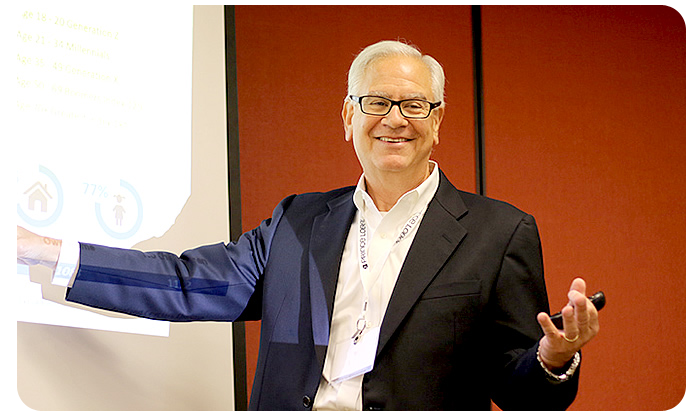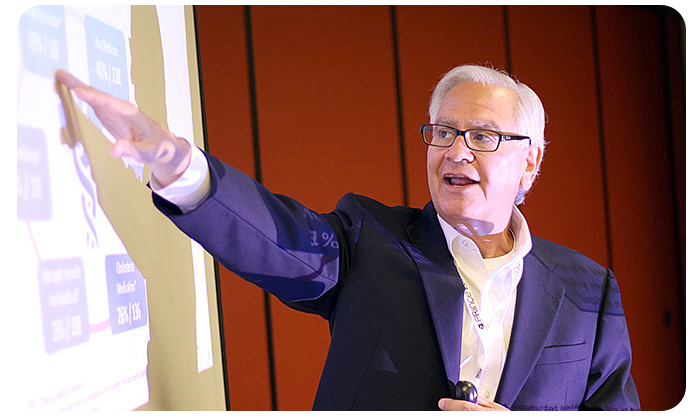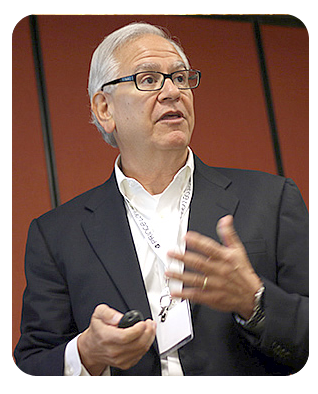By Alison Berstein,
Bulletin Correspondent

One thing I like to do is bust myths, and young people don’t read the newspaper? That’s a myth. They don’t read to the degree (of other consumers), but they still read.’
—Gary Meo, Senior vice president, sales director of newspaper media
Nielsen Scarborough, New York City
No two people are the same. Each person has different interests, hobbies, and passions.
There is a beauty that comes with that idea.
But that idea also poses challenges for companies looking to reach their audiences effectively.
Gary Meo discussed those challenges and their solutions in his workshop on “Monetizing audiences: Demonstrating the value of your audiences for advertisers” at the New England Newspaper and Press Association winter convention.
About 30 people attended his talk Saturday, Feb. 25, at the Boston Marriott Long Wharf hotel.
Newspapers and other businesses need to understand the dynamics of the different audiences they serve, said Meo, senior vice president and sales director of newspaper media at Nielsen Scarborough, headquartered in New York City.
“Newspapers have different audiences by platform,” Meo said.
Companies target those audiences that are most likely to engage in an advertiser’s message, Meo said.
“Advertisers are interested in selling to a portion of the audience, not an entire audience,” he said.
Nielsen Scarborough is a local market analysis service. It serves companies around the country by measuring consumer behavior.
“We measure retail behavior,” Meo said. “We measure all of the local media.”
Studying and understanding consumer behavior is “the way to demonstrate the connection between their brand and your audience,” Meo said.
Meo uses what is known as audience segmentation – dividing a market into segments, each with its own needs and spending patterns.
“How do your readers measure up to the market as a whole?” he said. “This kind of person is more likely (to engage in a certain consumer behavior) compared to a general audience.”
Meo stressed the importance of understanding each segment.
Because each subpopulation of consumers has its own needs, it responds in a different way to a message, Meo said.
Meo segments a newspaper’s audience into four categories:
A little less than half of the newspaper readers in the United States are what he calls “print loyalists”, who consume the newspaper solely in print. That accounts for 4.2 million adults in New England, or 47 percent of the New England adult population, Meo said.
About 20 percent are “dual devotees,” who read the newspaper in print and on one other platform.
Sixteen percent are “digital dignitaries,” reading just on digital devices.
The final 18 percent are “digital omnivores,” who consume the news through a variety of platforms. “We like them,” Meo said. “They’re seeing your advertiser’s message multiple times.”
Meo said the printed newspaper is still a viable contender in the eyes of consumers.
“You don’t want to abandon print just yet, because it’s the largest chunk of your readers …,” he said. “Print is still a big part of our portfolio.”
“One thing I like to do is bust myths, and young people don’t read the newspaper? That’s a myth,” he continued. “They don’t read to the degree (of other consumers), but they still read.”
Meo said 78 percent of consumers engage in the paper via print and on other platforms.
“Print isn’t falling off a cliff,” he said. “It’s still a big part of your audience.”
It is definitely a big part for print loyalists, who read the newspaper only in print.
Meo said the average age in that group is 54.
“People who read the printed paper exclusively are older,” he said. “We lament that our readers are getting older, but they’re an important group.”
Consumers in that group tend to be well-to-do, and therefore are valuable to the retail industry, Meo said.
Being a fan of the printed newspaper also translates into engaging with print advertisements, Meo said.
“They interact with print advertisers, they cut the coupons,” he said.
About one in five consumers are “dual devotees,” reading the newspaper in print and on one other platform, Meo said.
That is a younger group, with an average age of 48, Meo said. Forty-nine percent are millennials, he said.
“When you introduce digital into the mix, your audience gets a lot younger,” he said.
Those consumers pursue investments and use credit cards, Meo said.
They also are valuable to the travel industry, because they are more likely to travel, Meo said.
Members of the third group, digital dignitaries, read solely on digital platforms.
“They are definitely connected. They are digital natives,” Meo said of that group, whose average age is 39.
Advertising to them requires strategy on the part of digital advertisers, Mao said.
“They do not like to be advertised to on their mobile phones,” he said. “It has to be interesting, compelling, relevant.
“It’s all about relevancy,” he said. “They see their mobile phones as their property, their space, and they don’t want advertisers encroaching on that space.”
The final group, news omnivores, engages with newspapers and other businesses on a variety of platforms.
Their average age is 43 and they are valuable to the technology industry, Meo said. Digital omnivores use technology in their cars, such as satellite radio and wireless capabilities.
Those active, highly engaged consumers provide an abundance of opportunity for advertisers to reach out, Meo said.
“If you’re running advertisements on all of your platforms, your omnivore readers are seeing those ads on those platforms,” he said.

‘Advertisers are interested in selling to a portion of the audience, not an entire audience.’
—Gary Meo


